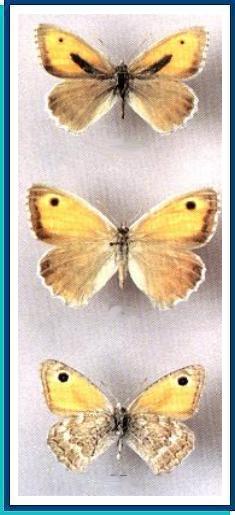LEPIDOPTERA
S A T Y R I D A E Boisduval, 1833
HYPONEPHELE Mushamp, 1915
Hyponephele narica (Hubner, 1805)
Hyponephele narica (Hubner, 1805)

· TYPE LOCALITY. Unknown, presumably the lower Volga basin near the Caspian Sea.
· RANGE. From the lower Volga flow and the Caspian Sea eastwards across the desert and semi-desert areas of Turkmenia, Uzbekistan, Kazakhstan, N. Iran, Afghanistan, Pakistan and N. India to Dzhungaria, Zaisan and the S. Altai (the Irtysh Valley).
· DISTRIBUTION AND VARIATION. The distribution of the species needs to be refined, because in many areas (from Afghanistan to Zaisan) it occurs sympatrically with the similar species H. naricina which was often treated in the past as a subspecies of H. narica. The status of a local population in SE. Kazakhstan, viz. the Ili River valley, requires clarification as well.
· HABITAT AND BIOLOGY. The species is characteristic of semi-desert and desert-clad foothills up to 1,500-1,700 m a.s.l., where it is found in wormwood-grassy habitats, also on salines. Flight period: May-June.
· SIMILAR SPECIES. H. naricina: FW apex less strongly pointed; male androconial area narrow; UNH veins grey, median band inconspicuous. H. naricoides: UPS brown-black margins broad; FW apical eye-spot in male larger; UPF in both sexes with a conspicuous dark spot at end of cell and with an obscure brown median band at costal edge; UNH veins grey; female UPS ochreous-yellow ground colour darkened, especially so at base. H. fusca: brown-black margins broader; FW apical eye-spot larger; male androconial area broader; female FW with a brownish angled median band.
Photo and text: Guide to the BUTTERFLIES OF RUSSIA and adjacent territories Volume 1. PENSOFT, Sofia - Moscow. 1997